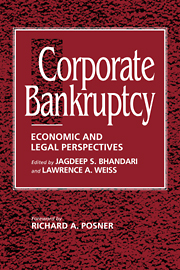Book contents
- Frontmatter
- Contents
- List of tables and figures
- Foreword by the HONORABLE RICHARD A. POSNER
- Preface
- Part I The role of credit
- Part II Bankruptcy as a reflection of the creditors' implicit bargain
- Part III Beyond the basic creditors' bargain
- 9 Bargaining after the fall and the contours of the absolute priority rule
- 10 On the nature of bankruptcy: An essay on bankruptcy sharing and the creditors' bargain
- 11 A simple noncooperative bargaining model of corporate reorganizations
- 12 Commentary on “On the nature of bankruptcy”: bankruptcy, priority, and economics
- 13 Bankruptcy and risk allocation
- 14 The corporate bankruptcy decision
- 15 Bargaining over equity's share in the bankruptcy reorganization of large, publicly held companies
- 16 Bankruptcy resolution: Direct costs and violation of priority of claims
- 17 The costs of conflict resolution and financial distress: Evidence from the Texaco-Pennzoil litigation
- 18 Survey of evidence on business bankruptcy
- Part IV Workouts or bargaining in the shadow of bankruptcy
- Part V Alternatives to bankruptcy and the creditors' bargain
- Part VI Experience of other countries
- Index
9 - Bargaining after the fall and the contours of the absolute priority rule
Published online by Cambridge University Press: 10 December 2009
- Frontmatter
- Contents
- List of tables and figures
- Foreword by the HONORABLE RICHARD A. POSNER
- Preface
- Part I The role of credit
- Part II Bankruptcy as a reflection of the creditors' implicit bargain
- Part III Beyond the basic creditors' bargain
- 9 Bargaining after the fall and the contours of the absolute priority rule
- 10 On the nature of bankruptcy: An essay on bankruptcy sharing and the creditors' bargain
- 11 A simple noncooperative bargaining model of corporate reorganizations
- 12 Commentary on “On the nature of bankruptcy”: bankruptcy, priority, and economics
- 13 Bankruptcy and risk allocation
- 14 The corporate bankruptcy decision
- 15 Bargaining over equity's share in the bankruptcy reorganization of large, publicly held companies
- 16 Bankruptcy resolution: Direct costs and violation of priority of claims
- 17 The costs of conflict resolution and financial distress: Evidence from the Texaco-Pennzoil litigation
- 18 Survey of evidence on business bankruptcy
- Part IV Workouts or bargaining in the shadow of bankruptcy
- Part V Alternatives to bankruptcy and the creditors' bargain
- Part VI Experience of other countries
- Index
Summary
The absolute priority rule provides that in a reorganization senior owners are paid in full before junior owners are paid anything. When a firm owes more than its assets are worth, the shareholders receive nothing unless the creditors consent. Under the 1978 Bankruptcy Code, consent can be given through a classwide vote of creditors. A single uncompromising creditor's objection is not sufficient to prevent the participation of shareholders. Nevertheless, the absolute priority rule and its rhetoric stand in distinct contrast to the distrust of market mechanisms and ex ante bargains that pervades both the practice of bankruptcy and discussions of bankruptcy policy. Walter Blum's classic essay, “The Law and Language of Corporate Reorganizations,” takes as its theme this tension between the need for respecting the prebankruptcy bargain and the harshness of vindicating that bargain after the fact. Recognition of that tension permeates much of what he has written since. The insights contained in his work establish the common ground upon which all modern bankruptcy scholars stand.
The dispute in Case v. Los Angeles Lumber Products and the other opinions that gave rise to much of Walter Blum's work, however, developed only after the absolute priority rule was well into middle age. These cases all involved battles between a creditor or group of creditors on the one hand and shareholders on the other. In its infancy, the absolute priority rule involved not two parties but three. In this chapter, we make an effort to extend Walter Blum's work.
- Type
- Chapter
- Information
- Corporate BankruptcyEconomic and Legal Perspectives, pp. 113 - 140Publisher: Cambridge University PressPrint publication year: 1996



